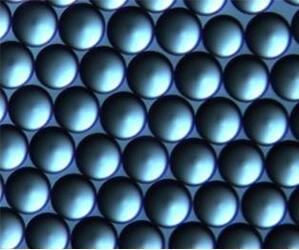Nano-Micro offers UniÒGel,UniÒ,UniÒMSP, and Nanoseries of monodisperse ion exchange chromatography media using a uniquede novo synthesis technology that is developed in-house. These ion exchange media meet the demands of downstream processing, from capture, intermediate purification, polishing and analysis. UniÒGel series possess a strong absorption capability toward biomolecules, even under considerably high ionic strength; therefore they are well-suited for the capture and initial purification of proteins. UniÒseries feature outstanding resolution, high loading capacity, and low non-specific adsorption, making them ideal for intermediate purification of proteins.Nanoseries are smaller in particle size, which is designed specifically for fine separation and analysis of proteins. All these types of media (resins) have the characteristics of high rigidity, good chemical stability, high resolution, low back pressure, and long lifetime, meeting the requirements of bio-analysis, separation, and manufacturing.
UniÒGel ion exchange media are made of hydrophilic acrylic microspheres with special functionalization on the surface. They provide a loading capacity twice as high as traditional ion exchange media, while resistant to high ionic strength. UniÒGelseries are uniform in particle size, with optimal hydrophilicity, good mechanical strength, and excellent chemical stability; these features make them particularly suitable for capture step (initial separation) in downstream processing.
UniÒseries ion exchange media are made from highly cross-linked acrylic microspheres with a hydrophilic coating; subsequently the desired ion exchange functional groups are later introduced onto the surface. Complete hydrophilic coating greatly reduces the non-specific adsorption between the stationary phase and biomolecules, assuring a better yield. The unique coating and derivatization technology enables UniÒseries media to have a high dynamic loading capacity of proteins. UniÒseries media are ideal for efficient separation of biomolecules such as proteins, nucleic acids, polypeptides etc.
UniÒMSPseries are multi-modal ion exchange media, with the same base resin and hydrophilic coating as UniÒseries. The co-existence of bonded ion exchange functional groups and surface hydrophobic groups leads to a mixed interaction of both ion exchange and hydrophilicity. In some cases of purification, UniÒMSPseries could show improved selectivity and resolution, they could also tolerate sample loading at high conductivity.
Nano series ion exchange media are based on monodisperse, highly cross-linked porous spheres of poly (styrene-co-divinylbenzene, PS/DVB). These porous resins are coated with a hydrophilic layer containing hydroxyl groups, and they are later derivatized with ion exchange functional groups. Nano media feature small particle size, uniform size distribution, pressure resistance, stability against acid and base, and high resolution. These ion exchange media are excellent for polishing (purification), in the manufacturing of antibodies, proteins, polypeptides, nucleic acids, etc., as well as analytical applications.
Features of Nano-Micro Tech Ion Exchange Media
High Uniformity of Particle Size
Nano-Micro manufactures ion exchange media of highly uniform particle sizes (Fig. 1), with precise pore structures. The product line includes UniÒGel, UniÒ, and UniÒMSP series media based on polyacrylic matrix, and NanoÒseries of media based on poly(styrene-co-divinylbenzene, PS/DVB). All ion exchange media from Nano-Micro come with distinct advantages of lot-to-lot reproducibility, easy column packing, etc.

Figure 1.SEM micrographs of IEX media from Nano-Micro (left) and an international market leader (right)
Outstanding Mechanical Strength
Nano-Micro IEX media are made from highly cross-linked polyacrylic or poly (styrene-co-divinylbenzene, PS/DVB). They have a remarkable advantage of outstanding mechanical strength, when compared with those ion exchange resins based on dextran or agarose. Nano-Micro IEX media have shown little change in bed volume (Fig. 2), with increasing flow rate or pressure. This feature greatly improves efficiency of downstream processing, and it also addresses the need for a linear scale-up from the lab to manufacturing.

Figure 2. Comparison of a polyacrylic IEX media from Nano-Micro and an agarose IEX media from a commercial supplier (pressure vs. flow rate curve)
Good Chemical Stability
Nano-Micro IEX media are made from highly cross-linked polyacrylic or poly(styrene-co-divinylbenzene). They maintain a good stability over a wide range of pH, which gives customer more rooms of operation (parameters/conditions) to achieve process development and optimization.

Figure 3. Alkaline resistance test of UniÒseries of ion exchange media
High Resolution
Nano-Micro IEX media have shown higher resolution and better recovery than a competitor’s IEX media in the separation of biomolecules, such as proteins, nucleic acids, polypeptides, and polysaccharides (Fig. 4 & 5).

Figure 4. UniÒCM-50XS vs. a competitor’s IEX medium in separation of proteins

Figure 5. NanoSP-10L in separation of proteins
High Loading Capacity
With uniform particle sizes, optimized pore structure, and unique surface coating/derivatization, Nano-Micro IEX media have higher loading capacity than international competitor’s IEX media (Fig. 6).

Figure 6. Comparison of dynamic loading capacity of Lysozyme, UniGel-80DEAE vs. an international competitor’s IEX medium

Figure 7. Dynamic loading capacity of UniGel-80DEAE under different linear flow rates
List of Products

bio-equip.cn












